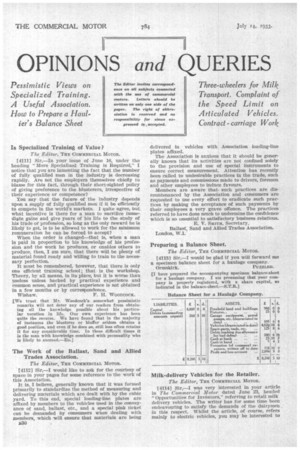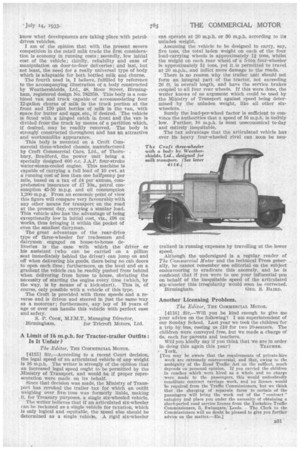OPINIONS and QUERIES
Page 44

Page 45

If you've noticed an error in this article please click here to report it so we can fix it.
Pessimistic Views on Specialized Training. A Useful Association. How to Prepare a Haul ier's Balance Sheet
Three-wheelers for Milk Transport. Complaint of the Speed Limit on Articulated Vehicles. Contractcarriage Work Is Specialized Training of Value ?
The Editor, THE COMMERCIAL MOTOR.
[4111] Sir,—In your issue of June 16, under the heading "More Specialized Training Ls Required," I notice that you are lamenting the fact that the number of fully qualified naen in the industry is decreasing rapidly. Are not the employers themselves chiefly to blame for this fact, through their short-sighted policy of giving preference to the hlusterers, irrespective of their experience or competence?
You say that the future of the industry depends upon a supply of fully qualified men if it be efficiently to compete in the world's markets. I quite agree, but what incentive is there for a man to sacrifice immediate gains and give years of his life to the study of his trade or profession, so long as the only reward he is likelY' to get, is to be allowed to work for the minimum
remuneration he can be forced to accept? '
When the order is changed—that is, when a man is paid in proportion to his knowledge of his profession and the work he produces, or enables others to produce, then, I am sure, that there will be plenty of material found ready and willing to train to the necessary perfection.
It must be remembered, however, that there is only one efficient training school; that is the workshop. Theory, by all means, in its place, but it is worse than useless unless backed by practical experience and common sense, and practical experience is not obtained in a few months or by correspondence.
Wishaw. F. H. WOODCOCK.
[We trust that Mr. Woodcock's. somewhat pessimistic remarks will not deter any of our readers from obtaining all the knowledge possible about his particular vocation in life. Our own experience has been quite the reverse. We have found that in the majority of instances the blusterer or bluffer seldom obtains a good position, and even if he does so, still less often retains it for any considerable time. In these difficult times it is the man with knowledge combined with personality who is likely to succeed—En.] The Work of the Ballast, Sand and Allied Trades Association.
The Editor, THE COMMERCIAL MOTOR.
[4112] Sir,—I would like to ask for the courtesy of space in your pages for some reference to the work of this Association.
It is, I believe, generally known that it was formed primarily to standardize the method of measuring and delivering materials which are dealt with by the cubic yard. To this end, special loading-line plates are affixed by members to the vehicles used in the conveyance of sand, ballast, etc., and a special pink ticket can be demanded by consumers when dealing with members, which will ensure that materials are being
B30 delivered in vehicles with Association loading-line plates affixed.
The Association is anxious that it should be generally known that its activities are not confined solely to the provision and use of special instruments to ensure correct measurement. Attention has recently been called to undesirable practices in the trade, such as payments and commissions made to drivers, foremen and other employees to induce favours.
Members are aware that. such practices are discountenanced by the Association and consumers are requested to use every effort to eradicate such practices by making the acceptance of such payments by their employees a very grave offence_ The practices referred to have done much to undermine the confidence which is so essential to satisfactory business relations.
E. V. Smini, Secretary, Ballast, Sand and Allied Trades Association. London, W.1.
Preparing a Balance Sheet.
The Editor,TRE COMMERCIAL MOTOR.
[4113] Sir,—I would be glad if you will forward me a specimen balance sheet for a haulage company.
Ormskirk. PUZZLED.
[I have prepared the accompanying specimen balance-sheet for a haulage company. I am presuming that your company is properly registered, with a share capital, as indicated in the balance-sheet.—S.T.R.] Milk-delivery Vehicles for the Retailer.
The Editor, THE COMMERCIAL MOTOR.
[4114] •Sir,—I was very interested in your article in The Commercial Motor dated June 23, headed "Opportunities for InOntors," referring to retail milk delivery vehicles. The writer has for some time been endeavouring to satisfy the demands of the dairymen, in this respect. Whilst the article, of course, refers mainly to electric vehicles, you may be interested to
know what developments are taking place with petroldriven vehicles.
I am of the opinion that with the present severe competition in the retail milk trade the first considera tion is economy in running costs; secondly, low initial cost of the vehicle; thirdly, reliability and ease of manipulation on door-to-door deliveries; and last, but not least, the need for a really universal type of body which is adaptable for both bottled milk and churns.
The fourth need is, I believe, fulfilled by reference to the accompanying illustration of a body constructed by Weathershields, Ltd., 48, Moor Street, Birmingham, registered design No. 782359. This body is a Combined van and truck capable of accommodating four 12-gallon churns of milk in• the truck portion at the front and 170 pint bottles of milk in the van, with space for butter and eggs, etc., if desired. The vehicle is fitted with a hinged catch in front and the van is divided train the truck by means of a partition which, if desired, may be readily removed. The body is strongly constructed throughout and has an attractive and workmanlike appearance.
This body is mounted on a Croft Commercial three-wheeled chassis, manufactured by Croft Commercial Cars, Ltd., of Thornbury, Bradford, the power unit being a specially designed 600 c.c. J.A.P. four-stroke water-steam-cooled engine. This machine is capable of carrying a full load of 10 cwt. at a running cost of less than one halfpenny per mile, based on a tax of £4 per annum, comprehensive insurance of £7 10s., petrol consumption 45-50 m.p.g. and oil consumption 1,200 m.p.g. From an economic point of view this figure will compare very favourably with any other means for transport on the road at the present day, carrying a similar load. This vehicle also has the advantage of being exceptionally low in initial cost, viz., £98 ex works, thus bringing it within the pocket of even the smallest dairyman.
The great advantage of the rear-drive type of three-wheeler for tradesmen and dairymen engaged on house-to-house deliveries is the ease with which the driver or his assistant (who can be carried on a pillion seat immediately behind the driver) can jump on and off when delivering his goods, there being no cab doors to open each time; furthermore, on the level and on a gradient the vehicle can be readily pushed from behind when delivering from house to house, obviating the necessity of starting the engine every time (which, by the way, is by means of a kick-start). This is, of course, only possible with a vehicle of this type.
The Croft is provided with three speeds and a reverse and is driven and steered in just the same way as a motorcar; furthermore, any boy of 16 years of age or over can handle this vehicle with perfect ease and safety.
S. P. Cook, M.I.M.T„ Managing Director, Birmingham. for Tricroft Motors, Ltd.
A Limit of 16 m.p.h. for Tractor-trailer Outfits : Is It Unfair ?
The Editor, THE COMMERCIAL MOTOR.
[4115] Sir—According to a recent Court decision,. the legal speed of an articulated vehicle of any weight is 16 m.p.h. The writer is strongly of the opinion that an increased legal speed ought to be permitted by the Ministry of Transport, and would be if proper representation were made onk its behalf.
Since that decision was made, the Ministry of Transport has revoked the trailer tax for which an outfit weighing over five, tons was formerly liable, making , it, for Treasury purposes, a single six-wheeled vehicle. The writer believes that if an articulated six-wheeler can be reckoned as a single vehicle for taxation, Which is only logical and equitable, the speed also should be determined as a single vehicle. A rigid six-wheeler can operate at 20 m.p.h. or 30 m.p.h. according to its unladen weight.
Assuming the vehicle to be designed to carry, say, five tons, the total laden weight on each of the four load-carrying wheels is approximately 11 tons, whilst the weight on each rear wheel of a 5-ton four-wheeler is approximately 34 tons, yet it.is permitted to travel at 20 m.p.h., and inflict more damage to the roads.
• There is no reason why the trailer unit should not form an integral part of the tractor, not exceeding 26 ft. in overall length, and have the service brakes coupled to all four rear wheels. If this were done, the writer knows of no argument which could be used by the Ministry of Transport against speed being determined by the unladen weight, like all other six wheelers.
Surely the load-per-wheel factor is sufficient to convince the authorities that a speed of 16 m.p.h. is unduly low. Further, 16 m.p.h. is most uneconomical to-day and entirely inequitable.
The tax advantage that the articulated vehicle has over its heavy four-wheeled rival can soon be nett tralized in running expenses by travelling at the lower speed.
Although the undersigned is a regular reader of The Commercial Motor and the technical Press generally, he cannot remember one editorial on the subject endea.vouring to eradicate this anomaly, and he is confident that if you were to use your influential pen on behalf of the inequitable speed of the articulated six-wheeler this irregularity would soon be corrected.
Birmingham. GEO. S. BAIRD.
Another Licensing Problem.
The Editor, THE COMMERCIAL MOTOR.
[4116] Sir,—Will you be kind enough to give me your advice on the following? I am superintendent of our Sunday School. Last year we took the children for a trip by bus, costing us £10 for two 20-seaters. The" children were conveyed free, but we made a charge of 6s. each for parents and teachers.
Will you kindly say if you think that We are in order
in clang this again this year? TEiCHER. York.
[You may be aware that the requirements of private-hire work are extremely controversial, and that, owing to the ambiguity of the Road Traffic Act on the subleet, much depends on personal opinion. If you carried the children in coaches which were hired as a whole and no charge were made to the passengers, this would undoubtedly constitute contract carriage work, and no licence would be required from the Traffic Commissioners, but we think that the charging of separate fares to certain of the passengers will bring the work out of the contract" category and place you under the necessity of obtaining a short-period road service licence from the Yorkshire Traffic Commissioners, 5 Swinegate, Leeds, The Clerk to the Commissioners will no doubt be pleased to give you further advice on the Matter.—Ena




























































































